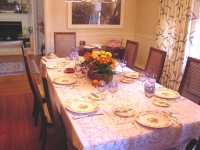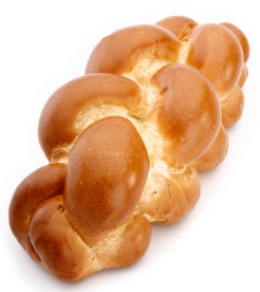Shabbat begins as night falls on Friday and ends after nightfall on Saturday. It is a very precious time of the week: a time where we stop all work, rest and remember that God is the creator of the world and everything in it. Because Shabbat is such a special time for all Creation, there are certain symbols we have and foods that we eat on Shabbat.
SYMBOLS
Candles
 The candle is a very important symbol for Jews.
The candle is a very important symbol for Jews.
- Candles are lit on Friday before Shabbat to help create Shalom Bayit (peace in the home), and Oneg Shabbat (Sabbath joy). In olden times, before electricity, lighting candles ensured that there was light in the room, that people could see what was in the room and avoid accidents, and that Shabbat would be more enjoyable than if observed in a dark room. The rabbis required people to light candles to increase Oneg Shabbat and Shalom Bayit. They did not just suggest that people use candles but actually required it for a simple reason – without the incentive of it being required by the rabbis, many poor people would have spent the Shabbat in darkness (synagogues used to have funds to help poor congregants afford Shabbat ‘necessities’ such as candles). The candles should be in the room where the Friday night meal is eaten.
- The woman of the house traditionally lights the candles, unless there is no woman. The candles can be lit up to one and a quarter hours before Shabbat begins, but usually, they are lit 18 minutes before sunset.
- Two candles (at least) must be lit in order to show shamor (observance) and zachor (remembrance) of Shabbat (the 4th of the 10 Commandments tells us to observe and remember the Sabbath day).
- We are allowed to light more than two candles. Some people light an additional candle for every child in the family. Once a person has the custom to light a certain number of candles for Shabbat, they are not allowed to reduce the number of candles.
- Ashkenazi Jews light the candles like this: The candles are lit, then motions are made with the hands as if encircling the lit candles and drawing them to the person, the eyes are covered with both hands and the blessing is recited, after which the person puts down their hands, looks at the flames of the lit candles and wishes everyone present a ‘Shabbat shalom’ (peaceful Shabbat). The blessing is translated as:
“Blessed are You, Lord our God, King of the universe, who has honoured us with mitzvot and commanded us to light the Shabbat candles.” We wave our hands around the candles seven times to draw light to ourselves and to welcome the Shabbat bride. The number seven reminds us that God created the world in six days and rested on the seventh.
- Sephardi Jews have a different custom; they say the blessing before they light the candles.
- Havdalah (the special ceremony at the end of Shabbat) is said with a plaited Havdalah candle, a cup of wine and fragrant spices, to say goodbye to Shabbat and welcome in a new week.
Shabbat Clothes
On Shabbat we put on our best clothes, dressing as if for an important occasion. This honours the Shabbat and reinforces the feeling that it is a special day.
The Shabbat Table
 The table should be covered with a special tablecloth (usually white), and set with the best china and silver to honour the Shabbat Queen. Shabbat food should be the tastiest and best. It is said that Shabbat adds a special flavour to your food. Foods which Ashkenazi Jews traditionally eat on Shabbat include gefilte fish, chicken soup, kugel, cholent and challah.
The table should be covered with a special tablecloth (usually white), and set with the best china and silver to honour the Shabbat Queen. Shabbat food should be the tastiest and best. It is said that Shabbat adds a special flavour to your food. Foods which Ashkenazi Jews traditionally eat on Shabbat include gefilte fish, chicken soup, kugel, cholent and challah.
- White is the preferred colour for the tablecloth as white is the colour of (spiritual) purity and therefore appropriate as the base for what we eat and do. It is a reminder that especially on Shabbat we should try to be spirtually pure.
FOODS
- For Shabbat lunch, a slow-cooked stew called ‘cholent’ is traditional, especially in winter when the weather is cold. It is allowed to put the cholent on to cook before Shabbat and then allow it to remain on a low heat until Shabbat lunch (or even later) so that we may enjoy hot food on the day of Shabbat.
- The eating of fish on Shabbat is interpreted as a symbol of the blessing that the children of Israel would multiply like the stars in the heavens and the sand of the seas (Judaism regards fish as a creature which multiplies easily).
Challah
 Challah is the traditional plaited bread especially baked for Shabbat and other holidays. Even today some women bake their own challah to indicate their love of Shabbat, but many people simply buy their challot (the plural of ‘challah’) ready-made from a shop.
Challah is the traditional plaited bread especially baked for Shabbat and other holidays. Even today some women bake their own challah to indicate their love of Shabbat, but many people simply buy their challot (the plural of ‘challah’) ready-made from a shop.- Challah means ‘dough’. Originally this name referred to the piece of dough broken off and given as a sacrifice whenever we made bread (see next paragraph), but it came to refer the special plaited loaves we make for Shabbat and holydays.
- It is a mitzvah (commandment) to separate a portion of bread dough, which is to be given to the priests (Kohanim) to eat. Since the destruction of the Temple, we keep this mitzvah by removing a portion from the top, or head, of the braided dough before it is baked. The piece is then burnt in the oven to symbolise and commemorate our sacrifice as well as the destruction of the Temple (a piece of challah for the ritual burning can be removed after baking if it has not been done before).
- When the piece of dough is taken to be burnt, the following blessing is recited: “Blessed are You, Lord our God, Ruler of the Universe, who has sanctified us with Your commandments and commanded us to separate challah.”
- Challah is made with white wheat flour which is more heavily processed (and therefore more expensive) than flour used to make what used to be the common bread of ordinary people (who mostly ate dark bread such as rye bread). For most people eating white bread was therefore a treat. Eating challah made of white bread therefore became an additional way of honouring the Shabbat and having a special food on it to increase our enjoyment of Shabbat.
- On Friday Night two challot (the plural of challah) are on the dinner table. This reminds is of the double portion of manna that was received from God on Fridays by the people of Israel in the desert so that they would have food to eat on Shabbat when they were not allowed to go out and gather manna.
- A blessing is recited before the breaking and eating of the bread. The blessing is: “Blessed are you, Lord our God, King of the universe, who brings forth bread from the earth.”
- After the bread has been blessed it should be salted to remind us of the sacrifices made in the Temple (where salt was added to the sacrifices).
- Before the challah is blessed, and during the blessing for the wine, the bread is kept covered by a cloth (known as the challah cloth). Normally bread is the first food blessed when we eat, but on Shabbat we first bless the wine when we make Kiddush and only bless the challah afterwards. To avoid ‘hurting the feelings’ of the challah, we shield the challah by covering it with a challah cloth while Kiddush is made and the wine drunk. This practices teaches us to respect the feelings of others.
 Wine and Kiddush Cup
Wine and Kiddush Cup
- Wine is very special and has its own blessing. Wine is used to show the holiness of the Sabbath when it comes in on Friday night (kiddush) and when it goes out on Saturday night (havdalah). The English word wine may derive from the Hebrew yayin.
- The blessing over wine is: “Blessed are you, Lord our God, King of the universe, creator of the fruit of the vine.”
- The kiddush cup is a special goblet set aside for the blessing of the wine. Many people have kiddush cups made from silver and they are usually beautifully decorated (again, a way of honouring Shabbat).
ZEMIROT
 Special songs for the Shabbat table are called zemirot. As the zemirot are sung, we can forget our weekday worries, and completely relax. Sometimes modern songs in Hebrew or English are added to the traditional zemirot.
Special songs for the Shabbat table are called zemirot. As the zemirot are sung, we can forget our weekday worries, and completely relax. Sometimes modern songs in Hebrew or English are added to the traditional zemirot.


